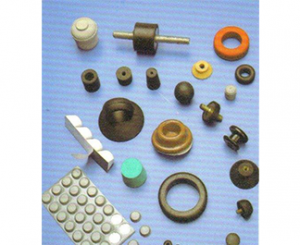 Material applications for silicone rubber are often thought of as a sealant. True, the material is used for o-rings and gaskets, but it is much more versatile. Silicone rubber grommets and tubing are examples of the many other products and components that are made from the material. Silicone rubber is a highly-resistant elastomer, i.e., a rubber-like material composed of the polymer silicone and joined together with carbon, hydrogen and oxygen molecules. Its structure offers many excellent mechanical properties—thermal stability, temperature resistance, durability, and high flexibility.
Material applications for silicone rubber are often thought of as a sealant. True, the material is used for o-rings and gaskets, but it is much more versatile. Silicone rubber grommets and tubing are examples of the many other products and components that are made from the material. Silicone rubber is a highly-resistant elastomer, i.e., a rubber-like material composed of the polymer silicone and joined together with carbon, hydrogen and oxygen molecules. Its structure offers many excellent mechanical properties—thermal stability, temperature resistance, durability, and high flexibility.
Such mechanical properties of silicone rubber make it an ideal material in a variety of applications across many industries. It is used in medical and healthcare, aerospace and automotive, food, electronics and electrical, textiles and footwear, and building and construction, among many other industries.

Some of the key benefits of silicone rubber are its:
Sterilization Capabilities
One of silicone rubber’s main mechanical properties is its thermal stability. Whether heat or cold, the material can operate in harsh environmental conditions and function in temperature range from minus 100°F to plus 500°F. Thus, its high steam resistance offers superior sterilization properties that meet FDA regulations. Because of it, silicone rubber is a widely used material for components in medical devices. Silicone rubber is non-toxic, biocompatible, medical-grade material. It can undergo a number of sterilization methods without affecting its properties. These methods include steam autoclaving, ethylene oxide, dry heat, gamma radiation, and electron beams.
Silicone rubber is used in such medical components and devices as tubing, valves, o-rings, catheters, drainage tubing, gaskets, and artificial membranes. It’s also used in cabling for medical devices and instruments, seals for dialyzers, medical pumps, IV components, feeding devices and implants, even baby bottle nipples, masks, medical textile coating and more.
High-Performance Properties
Silicone rubber is a high-performance elastomer with mechanical properties suited for a wide range of applications. Three exceptional properties that silicone rubber holds are its temperature resistance, durability, and flexibility.
Temperature
Most rubbers cannot withstand high working temperatures and often fail above 100°C (212°F). Silicone rubber applications exceed those working temperatures where most rubber cannot. Due to its thermal stability, the material is non-reactive, stable, and resistant to extreme temperatures and environments while still maintaining its mechanical properties.
Because of its high heat resistance, it provides excellent electrical insulation as well as for seals for high-temperature fluids. The material is used in the automotive industry in a variety of applications like gaskets, spark plug tires, radiators, heat exchangers, water-pump gaskets, and engine covers. It’s used in wiring and electrical applications like cable terminations, insulators, components for energy transmission, high heat lighting applications such as floodlights, lens molds, reflectors, and diffusers.
Durability
Silicone is considered an exceptionally durable polymer. The material can resist normal aging and deterioration for decades on end. Numbers of studies have shown that the material to only lasts, but can thrive in the most adverse environmental conditions. Whether it’s exposure to extreme heat and cold, sterilization processes, chemicals, adverse weather such as snow, salt spray, ultraviolet radiation, ozone, and acid rain, silicone rubber is up for the challenge.
Flexibility
Silicone rubber is an extremely flexible material. Its flexibility plays an important role in its widespread appeal in medical, aerospace, automotive, electrical, construction, and industrial applications. Easily manufactured, it retains its shape under the harshest conditions. Its primary uses are for seals, adhesives and molded flexible parts for numerous devices and components. It’s also used for cabling and tubing due to its ability to withstand the demands of high flexing cycles in the industrial applications ranging from electronics to medical devices. It retains its flexibility with good resistance to compression set over wide temperature ranges, which makes it an excellent sealant where low-temperature applications are required.

